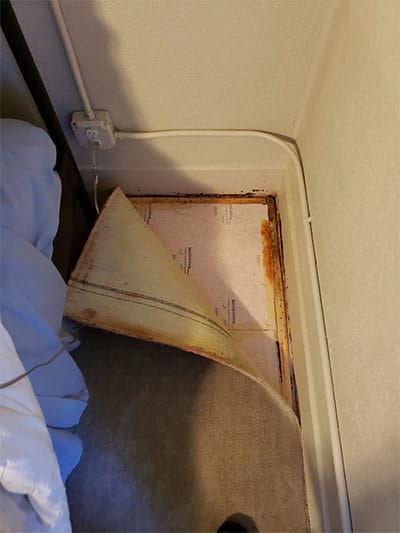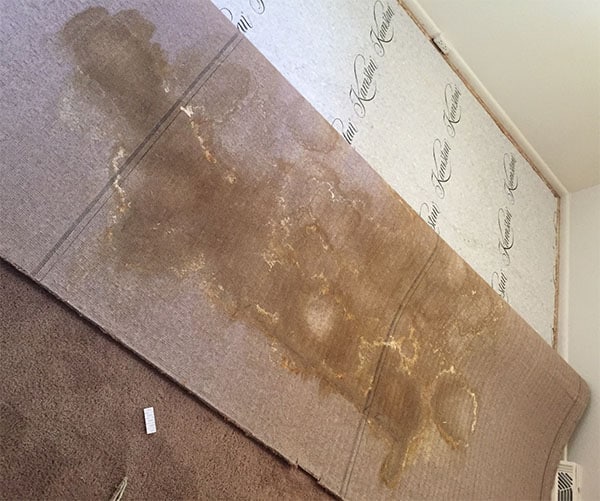How to Get Cat Urine Smell Out of Carpet
If you were to take a survey the worst smells present in carpet, cat urine in carpet must be among the most offensive odors for most people. Because of this, knowing how to remove cat urine from carpet properly is a must.
Home Remedies vs. Full Restoration
We are going to cover both some home remedy cat urine carpet cleaner options to try as well as the surefire (but much more manually intensive option) in this post. Feel free to try the home remedies first with the caveat that many times they are not fully successful due to the pungency of the cat urine.
Usually the solutions will be more successful with recent, wet cat urine spots, instead of areas that have been repeatedly used as a cat bathroom and/or sprayed and marked with cat urine. For those, full restoration is likely needed.

Home Remedies For How to Remove Cat Urine Smell From Carpet
Cleaning Fresh Cat Urine Stains
Cold Water and a Towel
Use cold water and an old towel or paper towels to absorb as much of the cat urine odor as possible. If you have a portable carpet extractor (many people falsely refer to these as “steam cleaners”), saturate the area with cold water and then extract it.
Repeat a few times. You can also use a shop vac to extract water, but be prepared to toss your filter out afterwards and thoroughly clean the inside of the shop vac.
Apply Enzymatic Cat Urine Carpet Cleaner
Next, apply a pet urine enzymatic cleaner. Natures Miracle is a good consumer product to remove the stains and odors. Especially any of the “Urine Destroyer” products. Follow the instructions on the container or spray bottle.
While there are numerous concoctions available online involving dish soap,baking soda, vinegar and water, hydrogen peroxide and so on, in our experience, the above solution is the one that will get you the best results for cat pet stains.
Steps for How to Clean Dried Cat Urine From Carpet and Severe Cat Urine Cleaning
- Locate and identify cat urine in carpet with a black light
- Manually inspect walls and baseboards in affected areas for damage
- Manually inspect for cat urine in carpet and pad
- Depending on severity, clean or remove baseboards and drywall
- Replace affected carpet pad and seal subfloor if necessary
- Thoroughly clean both the carpet fibers and backing with pet enzyme cleaner
- Let dry and reinstall carpet
Locating and Identifying Cat Urine in Carpet
There are a few methods to find the source of the cat urine smell. Our preference, and the preference of many professional carpet cleaning companies, is to use a black light. Cat urine glows under a black light due to the phosphorous contained in urine. This makes it easy to spot.
We recommend using a black light with a wide beam pattern and plenty of LEDs. You do not have to spend a fortune, and a cheap light can still work, it just makes the cat urine harder to see.
Using a Black Light
To use the black light, first turn off the lights and close the blinds. While it does not have to be completely dark in your home, trying to spot pet urine of any kind of daylight or a bright environment will be much tougher.
Next, scan the areas and identify where the cat urine smell is emanating from. Likely what you will find is that your problem may extend beyond simply having cat urine in the carpet. Often the cat pee has been sprayed on the baseboards, drywall, and an entire corner of the room. Take note of affected areas.
Manual Cat Urine Carpet and Wall Inspection
The next step is to see how bad the cat urine damage is. This is going to take a bit of poking, prodding, and pulling back the carpet.
After you’ve located the cat urine with the blacklight and before you start pulling back the carpet, we recommend examining the drywall and baseboards first. This will give you an idea of how bad the problem is and what level of deep cleaning you may need.
Cat Urine in Drywall and Baseboards
Start by using a blunt object, like a dowel or rod, to press on the drywall and baseboard. If a cat has frequently been using an area as a bathroom, many times you will find the drywall or composite baseboards have been saturated with urine.
Drywall will be soggy or crumbling, not firm. A light poke will not provide the resistance you would expect and may pass straight through. Baseboards (especially composite) will show visible damage like bubbling paint and warping.
Consider Calling a Professional
If you have damage as described above, now may be a good time to call a professional carpet cleaning company that specializes in pet odors and stains. These contaminated areas of drywall and baseboard likely need to be removed, sealed, and replaced.
Wood base boards can potentially be salvaged; however, drywall or composite baseboards will need to be discarded and replaced.
Inspecting the Carpet and Pad
Once you have located the cat urine with a blacklight and investigated the drywall and baseboards (assuming that is relevant to your issue), it’s time to really see how bad the cat urine in the carpet and pad is.
Pull Back and Examine the Carpet
Using needle nose pliers, you will need to reach under the baseboards and gently pull the carpet back, being careful not to rip the carpet. Once you have done this, it should be easy to spot the cause of the cat urine smell.
Examine the backing of the carpet. Cat urine should clearly show each ring or a cluster of rings where the cat has peed, and the urine has dried. It will appear as dark rings or a darkened area.

Look at the Tack Strips
Once the carpet has been lifted you can get a look at the carpet pad and the tack strips. Are the tack strips discolored, yellow or black? If so, those will need replacement.
Examine the Carpet Pad for Damage
Does the carpet pad have a moisture barrier? This will look like a plastic sheet on top of the pad. If so, it may be possible to clean it. If not, the carpet pad will likely show damage and should be replaced.
If the carpet pad does not have a moisture barrier, you should pull back the carpet pad to see if urine has made it through and into the subfloor beneath. Whether the subfloor is wood, or concrete is irrelevant.
Both are porous surfaces that cat urine odor can penetrate. If the urine has made it to the subfloor, it will need to eventually be encapsulated to get rid of the cat urine smell and keep it from creeping back up.

Surefire Method to Clean Dried Cat Urine From Carpet
Once you’ve identified the source of the cat urine odor, you have a few options. Either you can attempt to clean the area using a pet enzyme cleaner or other home remedies, or you can tackle the problem head on, knowing that you’ve done the job right.
In our experience, when dealing with cat urine, it’s best to remove damaged materials and replace them. Carpet itself can be thoroughly cleaned, however carpet pad (unless it has a moisture barrier) likely should be replaced.
Typically Cat Urine Stains Have Already Dried
Most of the time when you discover cat urine in a home, it already will be dried. Cats are often sneaky or are urinating in places that you may not initially notice. Often this discovery is not a single incident, either. Because it’s typically not an isolated incident, there is usually enough damage to warrant restoring the area, not just trying to cover up the odor.

Surefire Steps for How to Clean Cat Urine From Carpet
- If the drywall and/or composite baseboards are affected, cut out and discard the affected areas. For solid wood baseboards, you can likely paint them with two coats of Kilz oil based paint to seal them.
- If you have a moisture barrier on your carpet pad, clean it thoroughly the cat urine odor is gone. Otherwise, cut out and remove any cat urine saturated carpet pad and replace with a piece of pad that is of the same thickness and density.
- If cat urine made it through to the subfloor, clean the area, let it dry, then seal the subfloor (wood or concrete) with two coats of Kilz paint.
- Thoroughly clean and rinse both sides of the pulled back carpet. Both the face of the carpet and the backing will need to be thoroughly rinsed. Use a pet enzyme carpet cleaning solution for urine.
- If you have a portable extractor, that will work best. Repeat until odor is removed and carpet is thoroughly rinsed. Let the carpet dry. Use fans if you have them to speed drying. Make sure the urine smell is gone once dry.
- Replace any removed drywall or baseboards. Paint and prep the area.
- Reinstall the carpet using a knee kicker. If it is a large area, a power stretcher may be necessary to properly stretch carpet back into place
Call the Professionals
As a professional carpet cleaning and repair company, here at MSS Cleaning, we’ve tackled more cat urine issues than you can probably imagine. If you’re in the Greater Denver Area and need our help, feel free to give us a call or book an appointment online with us!
Or Call: 1-720-233-0761
